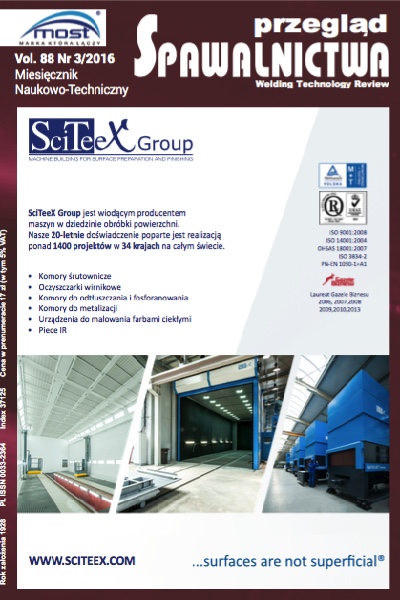Mikrostruktura natapianej powłoki Ni-Cr-B-Si
Main Article Content
Abstract
Stopy Ni-Cr-B-Si są stosowane do lutowania twardego oraz do modyfikacji powierzchni w celu zwiększenia odporności na zużycie ścierne. Lutem twardym z tej grupy jest BNi-2, stosowany do łączenia stali nierdzewnych, żaroodpornych stopów niklu oraz stali stopowych. W pracy lut BNi-2 w postaci folii wykorzystano jako materiał powłokowy. Stop po natopieniu i wygrzaniu w piecu próżniowym tworzy wielofazową powłokę. Celem pracy było opisanie mikrostruktury powłoki. Wyniki badań wskazują na występowanie czterech obszarów o różnej morfologii. Wykazano obecność roztworu stałego na bazie niklu, borków niklu, borków chromu oraz krzemków niklu.
Microstructure of the Ni-Cr-B-Si coating obtained in surfacing process
Abstract
The Ni-Cr-B-Si alloys are used for brazing and for surface modification to increase the wear resistance. The brazing alloy from this group is BNi-2, used for joining stainless steels, heat-resistant nickel alloys and alloy steels. In the work the brazing alloy BNi-2 in foil form was used as a coating material. The alloy after surfacing and soaking in a vacuum furnace forms a multiphase coating. The purpose of this work was to describe the microstructure of the coating. The results indicate on the incidence of four areas of different morphology. The presence of the solid solution based on nickel, nickel borides, chromium borides and nickel silicides was demonstrated.
Downloads
Article Details
Creative Commons CC BY 4.0 https://creativecommons.org/licenses/by/4.0/
Welding Technology Review (WTR) articles are published open access under a CC BY licence (Creative Commons Attribution 4.0 International licence). The CC BY licence is the most open licence available and considered the industry 'gold standard' for open access; it is also preferred by many funders. This licence allows readers to copy and redistribute the material in any medium or format, and to alter, transform, or build upon the material, including for commercial use, providing the original author is credited.
References
Burakowski T.: Areologia. Podstawy teoretyczne, Wydawnictwo Naukowe Instytutu Technologii Eksploatacji - PIB, Radom 2013.
Burakowski T., Wierzchoń T.: Inżynieria powierzchni metali podstawy, urządzenia, technologie, Wydawnictwa Naukowo-Techniczne, Warszawa 1995.
Burakowski T.: Rozważania o synergizmie w inżynierii powierzchni, Wydawnictwo Politechniki Radomskiej, Radom 2004
Ferenc K.: Spawalnictwo, Wydawnictwa Naukowo-Techniczne,
Warszawa 2013.
Knotek O., Lugscheider E.: Brazing filler metals based on reacting
Ni-Cr-B-Si alloys, Welding Research Supplement, October 1976,
s. 315-318.
Babul T., Kondej A.: Modyfikacja powierzchni stali przez natapianie
pasty BNi-2, Przegląd Spawalnictwa, nr 4, 2015, s. 2832.
www.aimtek.com
Kondej A., Babul T.: Struktura wielofazowej powłoki otrzymanej
po natapianiu pasty BNi-2 na podłoże stalowe, Inżynieria Powierzchni, nr 3, 2015, s. 10-16.
Jang J.S.C., Shih H.P.: Evolution of microstructure of AISI 304 stainless steel joint brazed by mechanically alloyed nickel base filler with different silicon content, Journal of Materials Science Letters, nr 22, 2003, s. 7982.
Villars P., Prince A., Okamoto H.: Handbook of ternary alloy phase diagrams, ASM International, Ohio, 1995.
Ou C.L., Liaw D.W., Du Y.C., Shiue R.K.: Brazing of 422 stainless steel using the AWS classification BNi-2 braze alloy, Journal of Materials Science, nr 41, 2006, s. 63536361.
